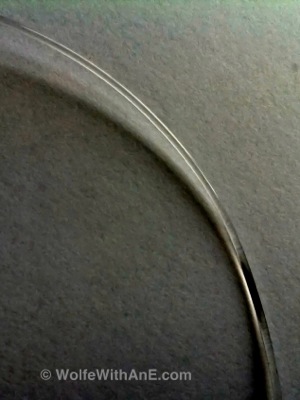Fishing for Ukulele String.

One of the not-so-secret secrets about the ukulele is that some of the best strings are made from fishing line. It’s true. There are a vast number of ukulele string producers out there and most have their strings made in Japan by companies that produce fluorocarbon angling leader. When you give it a little thought, companies that make fine fishing line already have the machines to produce string. So uke companies have worked with these producers to develop ingredient mixes, extruding temperatures and techniques to make some incredible sounding uke strings.
Fishing line sounds better.
I know that’s a bold statement, but Chet Aktins used fishing line for some of his guitars and that’s a pretty sound endorsement. Strings make almost as much difference in the sound of a uke as the uke itself. I bought a dozen string sets from different companies at Elderly Instruments to try on my ukes. Some sounded great and others sounded lackluster. (I do need to point out that there is one uke string in a class by itself. That’s Aquila’s Super Nylgut. These are patented nylon strings made in Italy. They have a pearl white finish, a beautiful tone and last forever. I use these on my Godin MultiUke.) But individual weights of fishing line allow you to experiment with each string for the best sound and feel from the uniqueness of each uke. I now have fishing line on my sopranos and tenors and have been very happy with the sound.
Seaguar, the Mother of All Fishing Lines.
I preferred the sound of Worth strings and all indications are that Worth has their clear strings made by Seaguar, the producer of the finest fluorocarbon leader for fishing. This line is made in two layers. The inner layer is hard, while the outer layer is soft. As uke strings, this keeps the Seaguars in tune and lasting a really long time, but makes them a littler easier on the fingers. I’ve had Seaguars on some of my ukes for over nine months. They show minimum signs of wear and are still bright and keep in tune.
Cost savings.
Seaguar comes in 25 and 50 yard spools so you have to make an initial investment of about $100-150. This will give you about 37 to 74 sets of string. For most players, having a dozen or more ukes is common, so you could easily pay out that much for individual string sets in a year. I figured that I now pay less than half of what commercial strings were costing me.
It comes down to the sound.
The sound of the Seaguars really caught my ear. I put them on my custom Boat Paddle Kayak and they sounded nicer than the Worth Clears it came with. My Flea came with Hilo black nylon strings, which I never thought matched it well. They now come with Aquilas, but the Seaguars are the only strings I’ve tried that to my ear do the unique design of the Flea justice. On most Ukes, the rich midrange of the Seaguars is complemented by a twinge of high treble.
What’s my line?
I have to thank Dave G. at Waverly Street Ukes for the assist on gauging the strings. His unique creations get Seaguars.
| Seaguar Sizing Chart | G | C | E | A |
|---|---|---|---|---|
| Dave G: Concert & Sporano | 40 lb | 60 lb | 50 lb | 30 lb |
| Concert & Soprano Low G | 80 lb | 60 lb | 50 lb | 30 lb |
| Light Tenor | 50 lb | 80 lb | 60 lb | 40 lb |
| Light Tenor Low G | 100 lb | 80 lb | 60 lb | 40 lb |
| Standard Tenor | 60 lb | 100 lb | 80 lb | 50 lb |
| Loose: Baritone Contrentrant | 100 lb | 150 lb | 130 lb | 80 lb |
| Kala Pocket Uke in C | 40 lb | 100 lb | 80 lb | 30 lb |
| Romero Creations XS Soprano Low G Bold | 100 lb | 80 lb | 50 lb | 30 lb |
| Romero Creations XS Soprano Low G Light | 100 lb | 60 lb | 40 lb | 25 lb |
| Godin MultiUke Light | 50 lb | 80 lb | 60 lb | 50 lb |
So, what’s it sound like?
Above is the tenor formula recorded on a Mainland Mahogany Longneck Concert Pineapple (concert body/tenor neck). They have a nice mellow presence and a tempered volume level. The video below includes a contrentrant strung Makala Baritone with the formula above.
A word on low G tuning.
In the Low G recipes above I’ve left the low G string a little thin so the sound might be considered slightly anemic. This is to allow the C string to remain dominant and really shine through. The low G adds depth chords and picking without taking their spotlight off the C string. If you want the low G to have more umph, use the next larger size in pounds.
My take.
String choice is as personal as uke choice. I’m not trying to sway the world to Seaguars. I just want to give you yet another fine-sounding string option and point out that the Seaguars are as good and durable as the top clear uke strings on the market today. These really do rank up there in quality and sound with the best uke strings you can buy and personally they’re my choice on all ukes I’ve tried them on. I know: some folks will now go to Walmart and buy discount nylon fishing line to try on their uke and will be severely disappointed. The Seaguars won’t disappoint.
Oh the black strings? They’re made from Dupont brush bristles. But that’s a story for another time.
